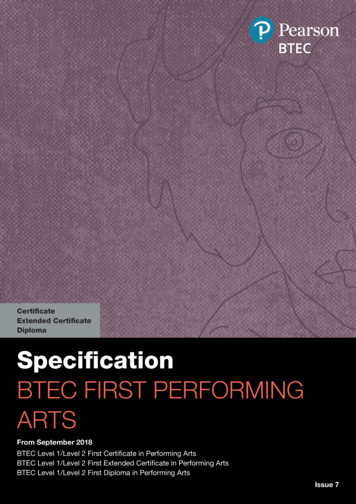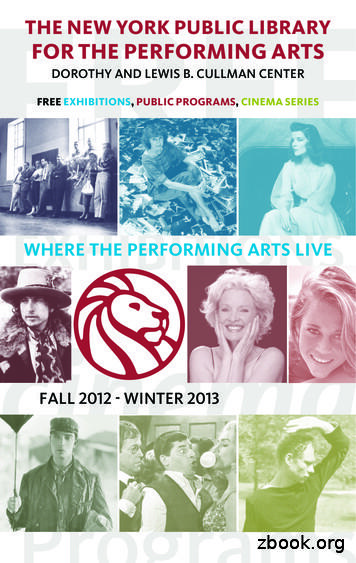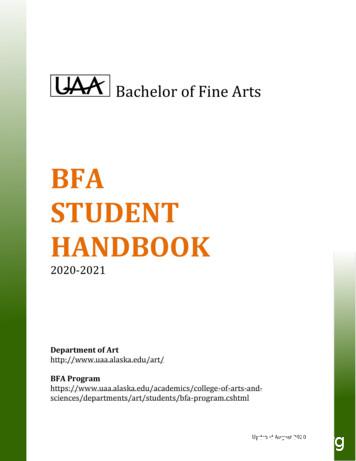THEATERS & PERFORMING ARTS GUIDELINES
PHASE 4: REVITALIZATIONTHEATERS &PERFORMING ARTSGUIDELINES RESTORE ILLINOISA Public Health Approach To Safely Reopen Our StatePART OF PHASE 4 OF RESTORE ILLINOIS PLANAPPLICABLE TO EACH REGION UPON TRANSITION TO PHASE IV ISSUED ON JUNE 22, 2020 EARLIEST EFFECTIVE DATE JUNE 26, 2020The Revitalization Phase of the Restore Illinois public health approach to reopening the Illinois economy includes larger gathering sizes,additional businesses reopening and increased capacities. We must all continue to social distance, frequently wash our hands and coverour faces to maintain progress in overcoming COVID-19.This document is applicable to businesses that meet the following criteria: Seated theaters, cinemas, and performing arts centers primarily engaged in showing live or pre-recordedperformances Examples of productions shown by theaters and cinema businesses include (non-exhaustive): plays, musicals,orchestras, operas, comedy/ improvisational shows, movies, pre-recorded events These guidelines apply to ticketed events with seating available for all customers; general admission shows and/orevents without seating (e.g., standing room only) are not permitted at this time Note: organizations that operate across multiple workplace environments should refer to applicable Phase IVguidelines for guidance on those workplaces Note: As of release, indoor theaters and performing arts venues should operate at lesser of 50 guests OR 50% ofoverall theater or performance space capacity. Outdoor theaters and performing arts venues should operate at 20%of overall theater or performance space capacity. Capacity restrictions and group sizes will be reassessed based onthe latest science and public health metrics on an ongoing basis throughout Phase IVUniform guidelines across businesses, industries and nonprofits within the State of Illinois:GENERAL HEALTHi. Minimum guidelines1. All employees who can work from home should continue to do so2. Employees should wear face coverings over their nose and mouth whenwithin 6-ft. of others (cloth masks preferred). Exceptions may be made whereaccommodations are appropriate – see IDHR’s guidance.3. Social distance of at least 6-ft. should be maintained between non-householdindividuals unless participating in activities permitted under Phase IV guidelines4. Employers should provide hand washing capability or sanitizer to employees andif applicable, customers5. Frequent hand washing by employees, and an adequate supply of soap/ papertowels and/or disinfectant/ hand sanitizer should be availablePAGE 1COVID-19 2020 THEATERSOFFICES REOPENING& PERFORMINGGUIDELINESARTS GUIDELINESPartPart ofof PhasePhase 43 ofof RestoreRestore IllinoisIllinois PlanPlan
THEATERS & PERFORMING ARTS GUIDELINESHR AND TRAVEL POLICIESi. Minimum guidelines1. All employees and workers who perform work at the worksite (such as temporaryor contract workers) should complete health and safety training related toCOVID-19 when initially returning to work. Resources to design a training areposted on the DCEO Restore Illinois guidelines website2. Employees should follow CDC travel guidance to protect themselves and othersduring business travel3. Employees should not report to, or be allowed to remain at, work if sick orsymptomatic (with cough, shortness of breath or difficulty breathing, fever of100.4 degrees or above, chills, muscle pain, headache, sore throat, new loss oftaste or smell, or other CDC-identified symptoms), and sick or symptomaticemployees should be encouraged to seek a COVID-19 test at a state or localgovernment testing center, healthcare center or other testing locations4. Employers should clearly explain all paid leave policies and make workers awarethat they may be eligible for benefits if they are sick or symptomatic5. Employers should be aware that the Occupational Safety and Health Act of 1970and provisions of state law prohibit employers from retaliating against workersfor raising safety or health concernsii. Encouraged best practices1. Provide reasonable accommodation for COVID-19-vulnerable employees, including but not limited towork from home (if feasible), reduced contact with others, use of barriers to ensure minimum distancebetween others whenever feasible or other accommodations that reduce chances of exposurePAGE 2COVID-19 2020 THEATERS & PERFORMING ARTS GUIDELINESPart of Phase 4 of Restore Illinois Plan
THEATERS & PERFORMING ARTS GUIDELINESHEALTH MONITORINGi. Minimum guidelines1. Employers should make temperature checks available for employees andencourage their use. Employers should post information about the symptomsof COVID-19 in order to allow employees to self-assess whether they have anysymptoms and should consider going home2. All employers should have a wellness screening program. Resources outliningscreening program best practices are posted on the DCEO Restoreguidelines websitea. Employers should conduct in-person screening of employees upon entry intoworkplace to verify no presence of COVID-19 symptomsb. If employee shift is greater than 5 hours, employers should also conductmid-shift screening to verify no presence of COVID-19 symptoms (in personpreferred, though virtually is permitted)3. If employee reports having any COVID-19 related symptoms, they shouldremain isolated at home for a minimum of 10 days after symptom onset ANDuntil feverless and feeling well (without fever-reducing medication) for at least72 hours OR confirmed to not have COVID-19 via 2 negative COVID-19 tests in arow, with testing done at least 24 hours apart4. If employee reports having any COVID-19 related symptoms, employersshould encourage employee to contact their health care provider; if multipleemployees report having any COVID-19 related symptoms, employers shouldnotify their local health department within three days of being informed ofthe prevalence of COVID-19 symptoms; if multiple employees test positive forCOVID-19, employers should notify their local health department within one dayof positive test results5. If an employee is identified as being COVID-19 positive by testing, CDCcleaning and disinfecting should be performed according to CDC guidelines6. Where appropriate, notify employees who have been exposed. Employersshould not identify an employee who tested positive by name7. Any employee who has had close contact1 with co-worker or any other personwho is diagnosed with COVID-19 should quarantine for 14 days after the last/most recent contact with the infectious individual and should seek a COVID-19test at a state or local government testing center, healthcare center or othertesting locations. All other employees should be on alert for symptoms of fever,cough, or shortness of breath and taking temperature if symptoms developii.Encouraged best practices1. A one-time nasal swab for RT-PCR testing of all live performers should beobtained within forty-eight to seventy-two hours prior to the start of work onset or location1Close contacts include household contacts, intimate contacts, or contacts within 6-ft. for 15 minutes or longer unless wearing N95mask during period of contact.PAGE 3COVID-19 2020 THEATERS & PERFORMING ARTS GUIDELINESPart of Phase 4 of Restore Illinois Plan
THEATERS & PERFORMING ARTS GUIDELINESGuidelines specific to theaters and performing arts:PHYSICAL WORKSPACEi. Minimum guidelines1. Venue operators should display signage at entry with face covering requirements, social distancingguidelines, cleaning protocols, and any reduced capacity limit, in multiple languages as needed2. On website and digital ticket purchasing sites, event organizers should clearly indicate face coveringrequirements, social distancing guidelines, cleaning protocols, and any reduced capacity limit, inmultiple languages as needed3. Allow for 6-ft. spacing between occupied ticketing workstations OR if not practical, install animpermeable barrier between ticketing workstations4. Venue operators should ensure at least 6-ft. between seats occupied by patrons that are not membersof the same household or party. If seats cannot be moved, venue operators should limit number of openseats to ensure social distancing5. For live performances, all individuals should maintain 6-ft. of social distancing unless job duty cannotbe performed without proximity (e.g. actors performing, hair, make-up, costumes) and should wear facecoverings if practical (e.g., string instrument performers in orchestra)6. For live performances, if first row of seating is within 6-ft. of stage, then any seating within 6-ft. of stageshould be closed OR impermeable barrier should be installed between stage and patrons7. Concessions should follow Restaurant and Bar guidelines for all food and beverage operations andshould be one of the following:a. Delivered by a server who takes orders from guests while seated with distancing requirements laidout in Restaurant and Bar guidelines; ORb. At outdoor kiosk, purchased pre-packaged via “grab and go” with queuing areas clearly marked toobserve social distancing ORc. At indoor quick service areas over 500 square feet, purchased pre-packaged via “grab and go” (noqueuing permitted)d. At indoor quick service areas 500 square feet and under, purchased pre-packaged via “grab and go”with queuing areas clearly marked to observe social distancing8. Concession stand employees should not refill patron food (e.g. popcorn) and/or beverage containers.Refills are still allowed at venue operators’ discretion, but must be completed using new food and/orbeverage containersii. Encouraged best practices1. Display visual markers 6-ft. apart at patron queue points2. If practical, install impermeable barrier between employee and patronat checkout3. If practical, implement touchless transactions4. Where possible, eliminate common touchpoints (e.g. remove shareditems in commons areas, use touchless door pulls)5. If practical, designate doors as entry-only and exit-only to reducelikelihood of close contact and congestion points6. For events that have security, utilize walk-through magnetometers toallow security workers to maintain social distance and avoid pattingdown any patronsa. If not practical, security workers performing pat-down searchesshould wear appropriate face coverings and gloves and have accessto a hand washing and/or sanitizing stationPAGE 4COVID-19 2020 THEATERS & PERFORMING ARTS GUIDELINESPart of Phase 4 of Restore Illinois Plan
THEATERS & PERFORMING ARTS GUIDELINES7. If practical, designate staging area for taxis and rideshare vehicles to drop patrons off8. Where building management practices allow, increase air turnover rates in occupied spaces andincrease outside make-up air to the maximum extent practical9. Prepare a venue-specific emergency evacuation plan that allows for patrons to maintain 6-ft.social distancing10. For live performances with musical accompaniment where orchestra pit space is limited, considerremote pit options11. If practical, performers use their own equipment (e.g., instruments, microphones)12. Where possible, minimize use of coat and bag checks and clean area frequentlyDISINFECTING/CLEANING PROCEDURESi. Minimum guidelines1. Cleaning and disinfecting of premises should be conducted incompliance with CDC protocols on a weekly basis2. Clean and disinfect common areas (e.g., restrooms, dressing rooms)and surfaces touched by multiple people (e.g., entry/exit doorknobs,stair railings) frequently; every 30 minutes recommended for hightraffic areas3. Clean and disinfect occupied tables and seats between use by differentgroups or parties, and again at closing time4. For live performances, minimize sharing of high-touch props andequipment between non-household participants. If props andequipment are to be shared, individuals (e.g. performers or supportstaff) should sanitize equipment before and after use (see EPAapproved list of disinfectants) and are encouraged to wash orsanitize hands5. Valet staff should perform cleaning of vehicle in compliance withGSA protocols6. All required disinfecting, cleaning, or sanitizing activities to beconducted by employees should be within their normal workday orduring otherwise compensated timeii. Encouraged best practices1. Allot extra time between show times and/or events to allow for more frequent cleaningPAGE 5COVID-19 2020 THEATERS & PERFORMING ARTS GUIDELINESPart of Phase 4 of Restore Illinois Plan
THEATERS & PERFORMING ARTS GUIDELINESSTAFFING AND ATTENDANCEi. Minimum guidelines1. Indoor venues should operate at lesser of 50 guests OR 50% of overall theater or performancespace capacity. Outdoor seated venues should operate at 20% of overall theater or performancespace capacitya. If venue has multiple performance areas, capacity restriction should apply toeach theater or performance space2. Venue operators should have a plan to allow for social distancing within the venue and if needed,designate employee(s) to monitor capacity limits and social distancing3. Venue operators should have a plan to limit congregation during entry/exit and throughoutduration of the event, including any intermissiona. For venues with multiple theaters or performance areas, schedule staggeredshow start and end timesb. If practical, schedule staggered patron arrival times (timed ticketing), with emailor mobile notificationc. If practical, allow patrons to select their entry time and locationd. If practical, limit number of unscheduled entriese. If practical, designate specific point of entry for patrons based on seating locationf. If practical, release patrons by row, beginning with those closest to exits (usevideoboard/ PA announcer to facilitate release)4. If applicable, venue operators should create plan to limit congregation in parking lots and assignparking spaces to patrons during the digital sales process5. Venue operators should limit the occupancy of common areas/ break rooms to allow for socialdistancing of 6-ft. or greater by removing/decommissioning furniture or staggering break times;this guideline is not intended to diminish employees break time requirements6. Venue operators should develop a method to inform customers of available facility capacitybefore customers arrive at the facility (e.g. reservation system, overview of days/ times whenestablishment is typically most crowded)ii. Encouraged best practices1. Stagger shift start and end times tominimize congregation of employeesduring changeoversPAGE 6COVID-19 2020 THEATERS & PERFORMING ARTS GUIDELINESPart of Phase 4 of Restore Illinois Plan
THEATERS & PERFORMING ARTS GUIDELINESEXTERNAL INTERACTIONSi. Minimum guidelines1. Before allowing external supplier or non-patron visitor to enter,or while requiring them to wait in a designated area, venueoperators should ask whether external supplier or non-patronvisitor is currently exhibiting COVID-19 symptomsa. If possible, venue operators should take external supplier ornon-patron visitor temperature using thermometer (infrared/thermal cameras preferred, touchless thermometerspermitted)2. Venue operators should keep log of all external suppliers whoenter premises3. Suppliers and non-customer visitors should wear face coveringsover their nose and mouth when entering premises (exceptionscan be made for people with medical conditions or disabilitiesthat prevent them from safely wearing a face covering)ii. Encouraged best practices1. Limit contact between external suppliers/ non-patron visitorsand employeesCUSTOMER BEHAVIORSi. Minimum guidelines1. Patrons should wear face coverings over their nose and mouth, except while seated within a venue(exceptions can be made for people with medical conditions or disabilities that prevent them from safelywearing a face covering)2. Patrons should check for available capacity before going to the facilityii. Encouraged best practices1. Before allowing entrance, venue operators ask whether patron is currentlyexhibiting COVID-19 symptomsa. If practical, venue operators take patron temperature using thermometer(infrared / thermal cameras preferred, touchless thermometers permitted)2. If practical, implement touchless transactions/ registration for patrons uponarrival to the event (e.g. mobile ticketing/ check-in)3. If applicable, patrons are encouraged to purchase online tickets in advanceof the show or performancePAGE 7COVID-19 2020 THEATERS & PERFORMING ARTS GUIDELINESPart of Phase 4 of Restore Illinois Plan
THEATERS & PERFORMING ARTS GUIDELINESIf you have questions or need additional support:Please call our hotline at 1-800-252-2923or e-mail us at ceo.support@illinois.govor return to Illinois.gov/businessguidelinesAdditional Resources: CDC Interim Guidance for Businesses and Employers CDC Workplace Decision Tool IDPH Releasing COVID-19 Cases and Contacts from Isolation and Quarantine IDPH Testing Guidance IDPH FAQs Symptoms of Coronavirus IDHR FAQ for Businesses Concerning Use of Face-Coverings During COVID-19 CDC Guidelines on Cleaning and Disinfecting Your Facility CDC Guidance on Cleaning Public Spaces, Workplaces, Businesses, Schools, and Homes EPA Disinfectants for Use Against SARS-CoV-2PAGE 8COVID-19 2020 THEATERS & PERFORMING ARTS GUIDELINESPart of Phase 4 of Restore Illinois Plan
ˆˇ This document is applicable to businesses that meet the following criteria: Seated theaters, cinemas, and performing arts centers primarily engaged in showing live or pre-recorded performances Examples of productions shown by theaters and cinema businesses include (non-exhaustive): plays, musicals,
Denver Center for the Performing Arts. Denver, CO . Dr. Phillips Center for the Performing Arts. Orlando, FL . Hult Center for the Performing Arts. Eugene, OR . Hylton Performing Arts Center. Manassas, VA . Jazz at Lincoln Center. New York, NY . Kimmel Center for the Performing Arts. Philadelphia, PA . Lesher Center for the Arts. Walnut Creek .
Performing Arts 35 Qualification structure of the Pearson BTEC Level 1/Level 2 First Diploma in Performing Arts (Acting) 37 Qualification structure of the Pearson BTEC Level 1/Level 2 First Diploma in Performing Arts (Dance) 39 Qualification structure of the Pearson BTEC Level 1/Level 2 First Diploma in Performing Arts (Production) 41
The Journal of Performing Arts Leadership in Higher Education is a peer-reviewed journal dedicated to the enrichment of leadership in the performing arts in higher education. Goals 1. To promote scholarship applicable to performing arts leadership 2. To provide juried research in the field of performing arts leadership 3.
The New York Public Library for the Performing Arts. 3. EXHIBITIONS. The New York Public Library for the Performing Arts. A collaboration with Lincoln Center . for the Performing Arts, Inc. In 1962, Lincoln Center initiated a program to commission posters by . prominent artists for the then newly-built performing arts complex. The
Queensland Performing Arts Centre The Queensland Performing Arts Centre (Centre), located within the Queensland Cultural Centre of South Bank, Brisbane is managed by the Queensland Performing Arts Trust (QPAC). As Queensland's state performing arts centre, QPAC's core mandate is to contribute to the cultural, social and intellectual
the visual and performing arts program at your child's school, key resources for getting started are provided. The arts learning examples in this guide are based on the Visual and Performing Arts Framework for California Public Schools, the California Visual and Performing Arts Content Standards and the National Core Arts Standards. While .
Elyse (Ginger Cooley) Applegate ARTS 332B 786-1683 Marketing and Public Relations e.a@alaska.edu Manager, Performing and Fine Arts Division Cedar Cussins ARTS 333 786-4890 Performing & Fine Arts cedar@alaska.edu Building Manager ART STUDIOS DRAWING Arts 101 (no phone) PAINTING Arts 102 786-1352 CERAMICS-HANDBUILT Arts 106 786-1246
health and care services should be delivering standards of care, and health outcomes, for prisoners that are at least equivalent to that of the general population. Doing so involves identifying and addressing health and care needs, which may have gone unrecognised, and supporting prisoners to lead purposeful, healthier lives. We recommend that: the National Prison Healthcare Board work .























